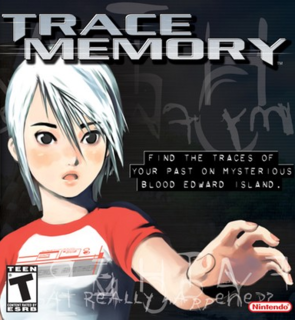If you get drawn in, you'll tear this thing apart in an afternoon. If not, you'll be stuck within 45 minutes.
Trace Memory's gameplay has an interface that most older gamers will find fairly recognizable. We're talking about your basic point-and-click adventure tweaked up a notch. The bottom screen gives you a top down view of a 3D polygon world, while the top screen displays static shots of the surrounding area that shift depending on your character's location within the current surroundings. Using a cursor you can select items to display these static shots on the bottom screen to investigate their contents more closely, often uncovering items or clues. One nice touch is that this game can be controlled entirely by either the directional and buttons, or by the stylus alone. If you want, you can even use both the buttons and stylus. I found this very handy when I was able to use the buttons instead of the stylus during my bumpy commute to and from work. Be warned that using the D pad to control the cursor requires a bit of finesse as it's movement gets a bit touchy and overly sensitive. All in all, you end up with a Myst-like experience but with more explanation, more narrative, and some very unique puzzles.
At its core, Trace Memory is a showcase for the DS's features via an array of puzzles with a story to connect them all together. The story has a pass/fail sort of appeal. You'll either be drawn into solving the mystery surrounding the murders of the main character's parents and the murders of your ghost friend's family, or you'll be completely turned off by the fact that you're going to be playing as a 13 year old girl. The game has a few interesting ways to incorporate the player into the storyline, such as the device that the main character receives is a dead replica of the DS unit itself. Also be sure to notice the character's date of birth. There's a fair bit of reading required here and that also may be a turn off for some players who want a faster pace out of their games.
The puzzles are definitely competent, if occasionally uneven in their difficulty. Some of the puzzles are immediately solvable and others have a pretty intense frustration factor. But it's a rare instance that you don't feel a certain level of accomplishment after succeeding in solving a puzzle. Some puzzles really show off the abilities of the DS and make clever use of it's characteristics, such as the reflective quality of the screens. Others can be a bit tedious because they basically amount to item fetching and back tracking. But if you're really interested in the storyline, you'll be willing to deal with these variations just to move the story along.
If you are that keen on solving the mystery and discovering the resolution to the story, you won't have long to wait. Trace Memory certainly falls short of an epic adventure, especially if you're determined. Replay value is also debatable as you've already solved these puzzles on your first run through. A bit more length would have been preferable, but Trace Memory is a solid experience while it lasts.

